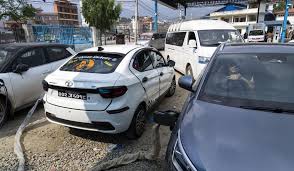 Kathmandu, June 7: Nepal’s abundant hydroelectric power is helping the Himalayan nation cut its oil imports and clean up its air, thanks to a boom in sales of electric vehicles.
Kathmandu, June 7: Nepal’s abundant hydroelectric power is helping the Himalayan nation cut its oil imports and clean up its air, thanks to a boom in sales of electric vehicles.Nearly all of the electricity produced in Nepal is clean energy, most of it generated by river-fed hydro-electricity. Thanks to that abundant source of power, the country is quickly expanding charging networks and imports of EVs have doubled in each of the past two years, according to customs data.
The Nepal Electricity Authority estimates use of EVs has reduced oil import costs by $22 million a year, and the savings are increasing.
Access to electricity in Nepal has soared in the past three decades as hydroelectric projects were completed. Now all but 6% of the population can reach the country’s fast-expanding grid. That is enabling the country to leapfrog its neighbors in adopting EVs.
Nepal so far has the peak capacity to produce 2,600 megawatts of power and that is increasing as new hydropower plants are completed. A very small amount of power is also generated by solar plants.
“Our electricity in the grid is from hydropower so it is clean energy. And so Nepal is ideally placed to use electricity to run our vehicles in the best way it should be, which is that the energy source itself is clean. It is not coal, gas or nuclear or petroleum,” said Kanak Mani Dixit, a leading environment and civil rights activist.
Official data on sales were not available, but Chinese automaker BYD’s Atto 3 and Indian maker Tata’s Nexon appear to dominate sales of electric passenger sedans.
Nepal has made boosting use of EVs part of its national commitments to curbing climate changing emissions, pledging to raise EVs to 25% of all auto sales by 2025 and 90% by 2030.
To help drive more sales, the government is charging lower duties on imported EVs, ranging from 25% to 90%. The import duties on gas and diesel-fueled vehicles are 276% to 329%.

